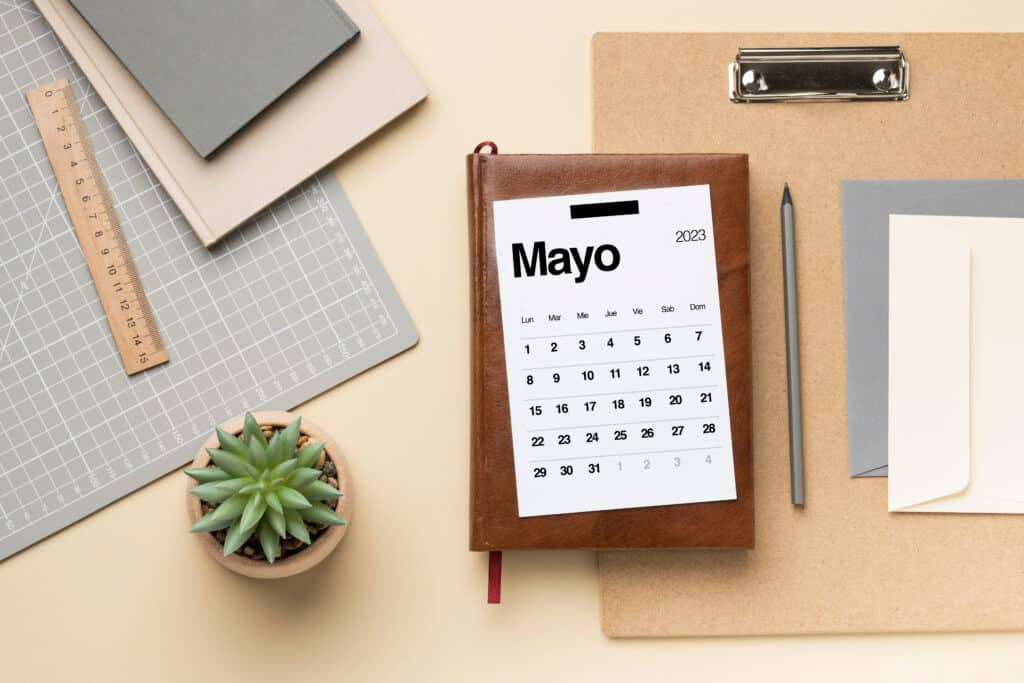
If you decide to learn Spanish in Madrid, or even if you’re taking online Spanish classes, one of the most useful vocabulary lessons will be learning how to say the date in Spanish and how to write the date in Spanish. That’s what we’re going to break down in this guide, which has been written by native Spanish teachers to help learners confidently use and understand dates in everyday situations. So let’s get straight into it!
It’s worth starting with some of the essential vocabulary related to saying dates in Spanish, such as months in Spanish, as well as the days of the week and how to say years in Spanish. This is a quick rundown of some of the most common terms you’ll use, along with the pronunciation:
| English | Spanish | Pronunciation |
|---|---|---|
| Monday | lunes | loo-ness |
| Tuesday | martes | mar-tess |
| Wednesday | miércoles | myer-co-less |
| Thursday | jueves | hweh-bess |
| Friday | viernes | byer-ness |
| Saturday | sábado | sah-bah-doh |
| Sunday | domingo | doh-meen-goh |
| English | Spanish | Pronunciation |
|---|---|---|
| January | enero | eh-neh-roh |
| February | febrero | feh-breh-roh |
| March | marzo | mar-thoh |
| April | abril | ah-breel |
| May | mayo | my-oh |
| June | junio | hoo-nyoh |
| July | julio | hoo-lyoh |
| August | agosto | ah-gohs-toh |
| September | septiembre | sep-tyem-breh |
| October | octubre | ock-too-breh |
| November | noviembre | noh-byem-breh |
| December | diciembre | dee-syem-breh |
| Year | Spanish | Pronunciation |
| 2025 | dos mil veinticinco | dohs meel beyn-tee-seen-koh |
| 2024 | dos mil veinticuatro | dohs meel beyn-tee-kwah-troh |
| 2010 | dos mil diez | dohs meel dyez |
| 2000 | dos mil | dohs meel |
| 1999 | mil novecientos noventa y nueve | meel noh-veh-syen-tos noh-ben-tah ee nweh-beh |
| 1900 | mil novecientos | meel noh-veh-syen-tos |
| 1492 | mil cuatrocientos noventa y dos | meel kwah-troh-syen-tos noh-ben-tah ee dohs |
There are some important structural differences between how dates are said in Spanish versus English, including with the order of elements.
In English, the structure will usually go: [Weekday], [Month] [Day], [Year]. For example, “Wednesday, January first, 2025”. However, in Spanish the typical Spain date format would be: [Weekday], [Day] de [Month] de [Year]. For example, “miércoles, 1 de enero de 2025”.
Another difference can be seen with articles and prepositions. When no weekday is included in the Spanish sentence, the definite article “el” is usually placed before the date,like “el 1 de enero de 2025”. And, as we saw above, the preposition “de” features in the Spanish date format more commonly than the English equivalent “of”.
Now that we know the typical Spain date format, which is [Weekday], [Day] de [Month] de [Year], let’s look at a few examples of how to use it in full sentences.
Now that we’ve looked at how to say the date in Spanish in words, let’s also consider how to write the date in Spanish in digits. With digits, the format can be a little more varied, as we’ll see below, although it is worth noting that the day almost always precedes the month in Spanish – unlike the American English style of putting the month first.
In the table below, we’ll go through a few different formats of expressing a date in digit form, explaining exactly how to write each date out fully, with a mix of words and numbers, and also how to say these dates in Spanish verbally.
| Format | Digit Example | Written Example (English) | Written Example (Spanish) | Verbal Example (Spanish) |
| DD/MM/YY | 01/01/2025 | January 1, 2025 | 1 de enero del 2025 | El primero de enero del dos mil veinticinco |
| DD-MM-YY | 02-01-2025 | January 2, 2025 | 2 de enero del 2025 | El dos de enero del dos mil veinticinco |
In Spanish, when referring to years from ancient history, you may come across the abbreviations a.C. (antes de Cristo, meaning “before Christ”) and d.C. (después de Cristo, meaning “after Christ”). These are used similarly to B.C. and A.D. in English. Note that d.C. comes after the year number in Spanish:
These abbreviations are essential when understanding timelines in Spanish and are widely used in textbooks, documentaries, museums, and academic writing.
Here are some examples:
| Year (English) | Spanish | Pronunciation | Notes |
| 44 B.C. | 44 a.C. | cuarenta y cuatro ah-seh | Year of Julius Caesar’s death |
| 1 B.C. | 1 a.C. | uno ah-seh | Last year before Christ |
| A.D. 1 | 1 d.C. | uno deh-seh | First year after Christ |
| A.D. 476 | 476 d.C. | cuatrocientos setenta y seis deh-seh | Fall of Western Roman Empire |
| A.D. 1492 | 1492 d.C. | mil cuatrocientos noventa y dos deh-seh | Columbus arrives in America |
Remember: the abbreviation comes after the number in Spanish.
In academic and neutral contexts, especially in recent decades, secular forms of these abbreviations are becoming more common. They focus on the historical era, not religion:
These forms are often used in scientific texts, museums, and by authors or institutions that prefer a religiously neutral terminology.
To finish, let’s look through a few more questions that frequently come up when thinking about how to say the date in Spanish and how to talk about dates in Spanish.
No, in Spanish the months and days of the week are not capitalised unless they begin a sentence. This differs from English and is a key point to remember when writing calendar dates in Spanish.
To say today’s date, you use “hoy es…” followed by the full date. For example, the full phrase could go like: “Hoy es el 1 de enero de 2025”.
To say the first day of the month, Spanish uses the ordinal number “primero” instead of “uno”, as we’ve seen in the above example of “el primero de enero”. The rest of the days use regular numbers, such as “el dos de enero” or “el tres de enero”.
In Spanish, the day comes first when writing dates, followed by the month and then the year. This is the standard across Spain and most Latin American countries, and is different to the American English style of putting the month first.
“Date of birth” is translated as “fecha de nacimiento” in Spanish.
“Save the date”, as in the term used on invitations for events such as weddings, is usually translated as “reserva la fecha” or “apunta el día”, while “anótalo en la agenda” is used as well.
Knowing how to tell time in Spanish can help you express full details about events. To combine the date and the time, you might say: “Es el 1 de enero a las 14h”, to mean “It’s on January 1 at 14:00”.
Spanish uses “en” with months and “el” with days: “en abril” (in April), “el 5 de mayo” (the 5th of May).
To link the day, month, and year, we use “de”: “5 de mayo de 2025”.
But be careful! Cita can also mean a date in the romantic sense.
So depending on the context, una cita can be your doctor’s appointment… or dinner with your crush!
Here are some useful phrases to talk about dates in Spanish, along with their English meanings and example answers:

